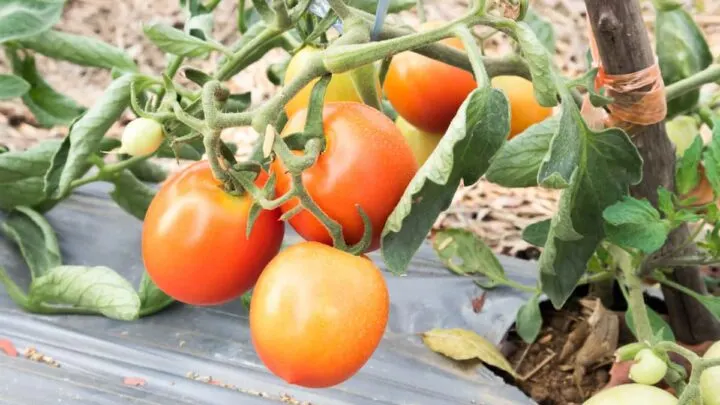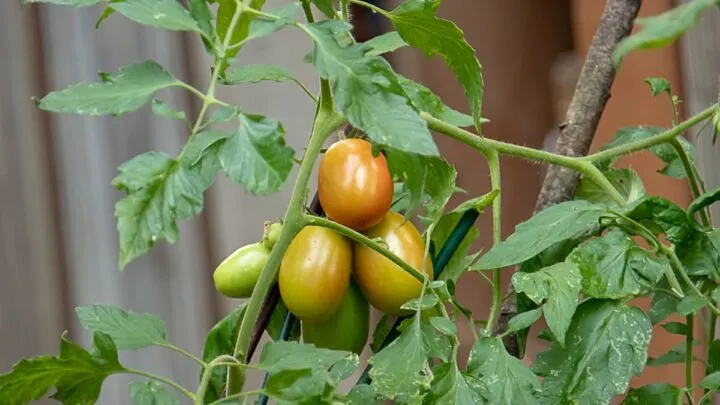One of the most popular plants to grow in a garden is tomatoes. It is easy to understand why; tomatoes themselves are very useful in a variety of dishes, they taste great, and they’re pretty easy to grow. Tomato plants are an excellent plant to start with if you are new to the world of gardening.
However, creating a garden can feel daunting even with an easier plant. If you’re looking to start your own garden, a raised bed can be perfect. This post will teach you how to grow Roma tomatoes in a raised bed step by step.

Buy Quality Seeds
The first step in starting any garden is buying the seeds! Roma tomatoes can be purchased as either seeds or seedlings. Not sure of the difference? Seeds are likely what you’re most familiar with; they are encapsulated embryonic plants.
On the other hand, Seedlings are just seeds that have only just begun to sprout. Seeds can be purchased in a lot of places like garden centers, supermarkets, and even on Amazon, but seedlings will likely have to be bought at a nursery.
Plant Seeds
Once you have your seeds or seedlings, it’s time to plant! While Roma tomatoes can be an easier plant to grow, it still does require certain things to ensure your plant is fruitful. For one, they require more time to grow.
It is not uncommon for people to start their Roma tomato plants inside for the first few months to ensure they are still within the required temperature range for successful growth. This range is between 65 degrees Fahrenheit and 90 degrees Fahrenheit. Anything outside of this range could lead to the plant being stunted in growth.
The state of the soil is just as important as the temperature. The starting soil mix you use should be damp enough to allow all the nutrients to easily sink in without being overly soaked. Plant the seeds or seedlings half an inch into the soil. Once you have planted them, make sure that plant is facing the south windows. If you don’t have any south-facing windows, opt for artificial lights. Either of these will help the plant get all the sunlight it needs. If your Roma tomato plant does not get enough light, it can topple over.
Move Plant Outside
After the six to eight weeks of inside growth, it’s time to move those plants outside for the rest of their growing journey. The process of moving a plant from inside to outside is often referred to as “hardening off.” The name comes from the change that your plant will be going through; inside, you watched it very closely and made sure it got all the sun and nutrients it needed.
Once it moves outside, things change. It gets harder on your plant initially because it needs to adjust to its new surroundings. If it’s not getting enough sunlight, you can no longer grab the pot and move it to a sunnier spot. Inside there is little to no chance of an animal disturbing the plant. You don’t have control over what pests go near your raised bed outside. Your Roma plant will have to endure whatever comes its way, good or bad.

How to Harden Off Roma Tomato Plants
Hardening off should be a slow build. If the process is rushed, it could damage the plant or even kill it altogether. For an hour or two, set your plant outside in the shade while still planted in the existing pot it was in a while inside your home. If you use seedlings instead, do this at night to ensure proper growth. Being outside for a brief period in the original pot will allow it to adjust to the climate while still being rooted in the soil it has known for the past few months.
From there, slowly increase the amount of sunlight the plant gets. You can increase this by a few hours at a time so that it continues to get more comfortable with the outside. It is also the perfect opportunity for your plant to get a slight breeze that will help increase stability. However, you don’t want too much of a good thing. If the wind is more potent than a slight breeze, consider placing the tomato plant outside at a different time to help make sure that it doesn’t get blown over.
The next step is to keep an eye on the plant. If you notice that it starts to droop or the weather is undesirable, don’t be afraid to move them to a shadier area to recover, and then try putting them back out again at a more optimal time. Once they have gotten to the point where you can leave them outside for several hours, for several days, it’s time to attempt leaving it out overnight. The entire process should take just about a week.
Before leaving your beloved Roma tomato plant outside overnight, you must thoroughly check the weather report. The temperatures need to remain in the high fifties for the entirety of the night. Once you have done this successfully, it’s safe to plant them in your raised bed permanently.
Time to Transplant
When it is time to transplant your Roma tomato plant into your garden, there are a few things you must do.
- Analyze your plants
- You need to ensure that all of your plants are stable enough for the transition. Look for short, stocky, green plants. Any plants that have begun to flower or are yellowing are not suitable for transplanting.
- Water first
- Be sure to water your plants while they are still in their pots.
- Secure plant installations
- Whether you opt for stakes, trellises, or cages, be sure to install them before you plant anything.
- Remove lower branches
- Take a moment to pinch and remove some of the smaller and lower branches that will only get in the way of other branches’ growth.
- Plant root ball
- Now we get to the true planting. Plant it deep enough that the lowest branches are only just above the soil.
- Space them apart
- To ensure that the tomato plants don’t grow together or get tangled, leave at least 14 to 20 inches in between each.
- Firm the soil
- Once the plants are in place, you will need to firm the soil to keep them in place. To determine if your soil is firm, you should be able to crush it under, but there should be some subtle pushback.

Looking After Roma Tomato Plants
Things are not over once your plants are in the raised bed. Now you switch back to caring for all of the plants to help guide them to harvest. To do that, you can care for Roma tomatoes like any other.
The soil should be warm, slightly acidic, and be able to drain. Sunlight is among one of the most important details. A tomato plant needs at least six hours of direct sunlight daily.
In regards to temperature, it’s imperative that it remains within the range of 55 degrees Fahrenheit and 90 degrees Fahrenheit most of the time. If temperatures lean towards the warmer side of this range, the more water the plants will require and vice versa. Be sure not to overwater.
Fertilization is a keep part of the process. There are a few ways to go about this for Roma tomato plants. When first planting them, you can add a slow-releasing fertilizer, add compost regularly, or utilize a liquid fertilizer every two to three weeks. Be sure to take note of the amount of nitrogen in the one you choose. Too much nitrogen can be harmful to tomato plants.
Lastly, for pruning and weeding, not too much is required. For one, no pruning is necessary. Too much trimming can limit the number of tomatoes that grow on the plant. For weeding, keeping a regular eye on it is always a good idea, but again, removing too much near the base of the plant can potentially be harmful.
Time to Harvest
Finally! The time has come, and you can start reaping the benefits of all your hard work. The harvesting period usually happens around 70 to 80 days after plantation. A great advantage of Roma tomatoes is that they all ripen simultaneously, so you get the satisfaction of a full batch when the time comes.
If, for some reason, the temperature drops below 50 degrees Fahrenheit, it will prevent them from ripening. But there’s no need to worry. All you need to do is bring the plants inside. Tomatoes can finish ripening indoors just fine.
Final Thoughts
If you are starting your first garden, Roma tomatoes are a great choice! Planting them in a raised bed is a great way to familiarize gardening. Learning as much as you can about the planting process will help ensure a bountiful yield that you can use to make pasta sauce or tomato paste in just a few months after plantation.
Be sure that you care for your Roma tomato plant inside for the first few weeks and ensure the temperature is just right for them to start growing outside in your raised bed by setting them outside a few hours at a time for about a week. Once you have them in the planter, you need to track the soil, the sunlight, and fertilizer intake, just like any other plant.
After all of this work, you will find that your tomato plant has grown several tomatoes, all of which have ripened around the same time and will be ready for harvesting. After your first successful batch, you will be hooked!

Hi there, my name is Allie and welcome to my blog; GareningWithAllie!
Much of what you see written here is just our personal experiences with gardening. Along with the content I write here, there is also a unique collection of gardening topics covered by some of our close friends. I hope you find everything you read here to be helpful, informative, and something that can make your gardening journey the most lovely experience ever! With that said, Happy Gardening!
